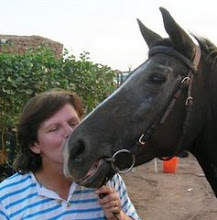Improved balance.
As the horse moves, the rider is constantly thrown off-balance, requiring that the rider's muscles contract and relax in an attempt to rebalance. This exercise reaches deep muscles not accessible in conventional physical therapy. The three-dimensional rhythmical movement of the horse is similar to the motion of walking, teaching rhythmical patterns to the muscles of the legs and trunk. By placing the rider in different positions on the horse (therapeutic vaulting), we can work different sets of muscles. Stopping and starting the horse, changing speed and changing direction increase the benefits.
Strengthened muscles.
Muscles are strengthened by the increased use involved in riding. Even though riding is exercise, it is perceived as enjoyment, and therefore the rider has increased tolerance and motivation to lengthen the period of exercise.
Improved coordination, faster reflexes, and better motor planning.
Riding a horse requires a great deal of coordination in order to get the desired response from the horse. Since the horse provides instant feedback to every action by the rider, it is easy to know when you have given the correct cue. Repetition of patterned movements required in controlling a horse quickens the reflexes and aids in motor planning.
Stretching of tight or spastic muscles.
Sitting on a horse requires stretching of the adductor muscles of the thighs. This is accomplished by pre-stretching prior to mounting the horse, and starting off on a narrow horse, gradually working to wider and wider horses. Gravity helps to stretch the muscles in front of the leg as the rider sits on the horse without stirrups. Riding helps to stretch the heel cords and calf muscles. Stomach and back muscles are stretched as the rider is encouraged to maintain an upright posture against the movement of the horse. Arm and hand muscles are stretched as part of routine exercises on the horse and by the act of holding and using the reins.
Decreased spasticity.
Spasticity is reduced by the rhythmic motion of the horse. The warmth of the horse may aid in relaxation, especially of the legs. Sitting astride a horse helps to break up extensor spasms of the lower limbs. Holding the reins helps to break flexor spasm patterns of the upper limbs. Many of the developmental vaulting positions are also designed to break up or reduce spasticity. Fatigue also helps to decrease spasticity by producing relaxation.
Increased range of motion of the joints.
As spasticity is reduced, range of motion increases. Range of motion is also improved by the act of mounting and dismounting, tacking up, grooming, and exercises during lessons.
Reduction of abnormal movement patterns.
If spasticity is reduced and range of motion increased, it follows that abnormal movements will be inhibited. Relaxation techniques while riding also help to inhibit abnormal movement.
Improved appetite and digestion.
Like all forms of exercise, riding stimulates the appetite. The digestive tract is also stimulated, increasing the efficiency of digestion.
Sensory integration.
Riding stimulates the tactile senses both through touch and environmental stimuli. The vestibular system is also stimulated by the movement of the horse, changes in direction and speed. The olfactory system responds to the many smells involved in a stable and ranch environment. Vision is used in control of the horse. The many sounds of a ranch help to involve the auditory system. All of these senses work together and are integrated in the act of riding. In addition, pro-prioceptors (receptors that give information from our muscles, tendons, ligaments and joints) are activated, resulting in improved pro-prioception.
Sunday, June 14, 2009
Subscribe to:
Post Comments (Atom)



No comments:
Post a Comment